#biggest bivalve
Explore tagged Tumblr posts
Text







I'm legit worried they eat people because of how large they are
#gigas clam#gigas giant clam#giant clam#coral reef#coral reefs#bivalve#biggest#biggest bivalve#plankton#algae#nutrients#happy as a clam#blathers#blathers the owl#acnh blathers#acnh npc#acnh museum#acnh swimming#acnh diving#acnh#acnh life#acnh island#acnh hype#acnh community#acnh blog#animal crossing#new horizons#animal crossing new horizons#animal crossing: new horizons#nintendo
7 notes
·
View notes
Text
The Middle Therocene: 35 million years post-establishment

Searet Relationships: Marine Fearrets of the Middle Therocene
As the Great Lakes of Nodera opened up to the seas, the aquatic hamsters of the large landlocked water would find a new frontier accessible to them: the oceans. First would come the tailless pondrats, expanding into the seas and becoming even more specialized to water to become the bayvers, a diverse clade including herbivores, omnivores and carnivores in their ranks. But they would find an ocean already contested by a now-dominant clade that reigned unchallenged in the absence of vertebrate competition in marine ecological niches: the shrarks. Growing to immense sizes for an arthropod, with the biggest being the two-meter long megaprawns of open seas, and armed with powerful 'biting' pincers, they patrolled the shallow coasts, reefs and open seas as the apex predators of their time. Originally hunting only other shrish species, many of which grew quite big at sizes of a meter or more, the bayvers found themselves quickly added to the menu: and thus, in these early days, remained semiaquatic and pinniped-like to escape onto the shores out of reach of the marine hunters, most restricted to bouncing and wiggling on their bellies on land, and some, the more basal wavewaddlers, retaining the ability to clumsily walk using their fused rear flippers: ties to the land being a constraint that had restricted their diversity for the past few million years.
But another species from the lakes had spread out from the seas in this time, and would eventually turn the tide in the favor of the hamsters. The lake searet, an ambush predator related to the carnohams, that fed on aquatic and terrestrial prey alike, found the Centralic Ocean a very welcome place to expand, and soon spread throughout the inner coasts of Ecatoria, Nodera, Westerna and Easaterra. In the past ten million years these had diversified, diverging into a wide array of species occupying varied niches.
Propelled by enlarged, webbed hind feet and tails adapted for steering, the searets were well-suited for maneuvering and foraging in the water. Their powerful jaws, in particular, made them superbly built for tackling hard-shelled prey: a useful adaptation that prevented them from competing with the other main marine hamster lineage of the time, the bayvers, which fed on smaller shrish, bottom-dwelling crustaceans, and even marine plants.
Brown coastal rodders (Lutromyocricetus vulgaris) are among the most basal of the species, and the most widespread. They have a preference toward hard-shelled prey too tough for bayvers to crack, such as slow-moving armored shrish. The bayvers, faster in the water, were pursuit hunters of shrish that specialized on speed and shoaling to evade predators, while rodders, more suited for maneuveravility, dexterity and stealth than speed, preferred those that were more heavily defended but were slower and easier to catch.
Some species, such as the dappled rockasheller (Duroclastemys circulupunctus), would even rely on beyond just their physical limitations, and augment their diet with the help of primitive tools as well. Using stones or bits of coral as blunt hammers, they break open the shells of bivalves, large snails, and heavily-armored lobster-like shrish as well, in order to access the nutritious meat within. This is primarily an instinctive, rather than learned, behavior: young rockashellers will often carry around small stones and use them to hit hard objects as an act of play, completely oblivious of the reason of this behavior and gradually learn to use this behavior for feeding through experience and imitation of older members of their species.
Marine searets, as a whole, are far more independent of land than bayvers are, and can in fact spend their whole lives at sea: feeding, sleeping, mating, grooming and bearing their young all while floating at the surface of the water, gathering in family groups of a dozen or two for safety. Fiercely protective of their packmates, they, instead of timidly fleeing from danger like bayvers do, instead mob and attack any predatory shrarks that threaten them, and occasionally even successfully killing their assailants: setting the stage for a complete overhaul of the dynamics of the ocean biomes as a whole.
Over time, this defensive mobbing behavior turned into active predation in some of the larger species, with shrarks, and other large shrish, no longer being seen as enemies or competitors, but as prey. The largest searet species of this time, the goliath searet (Titanolutromys goliah) can reach lengths of over eight feet from snout to tail and weigh about two hundred kilograms: making them formidable predators of the open seas, and the first hamsters to fill the niche. Goliath searets are powerful swimmers, so much so that they basically never come to land willingly, and, while big enough to prey upon bayvers, rarely do so unless desperate, as bayvers are too fast and evasive for their liking while they are much slower ambush hunters. Instead, their preferred prey of choice are the giant armored meter-long shrish abundant in the shallows, including filter-feeding, grazing and predatory members of their clade. At their size, they are large enough to tackle shrarks on their own, and now live by themselves or in mated pairs, as well as their offspring which stay with their parents for about two years before becoming fully independent.
Rather than becoming yet an additional danger to pose a significant threat in the water, if anything, the presence of the searets actually was a net benefit to the bayvers, as their rampant hunting of predatory shrarks in the shallows gradually forced the deadly arthropods further out to sea: and reduced the predator densities of the tropical coastal reefs that did prey on the bayvers regularly, to make a relatively safer sea for the marine pondrats to press onward into, and finally diversify. At long last, the monopoly of the seas by the shrish has been challenged by the hamsters: and in the eons to come, the searets' impact on the ocean ecology will have lasting effects felt even millions of years later as they, and the bayvers, attain remarkable proportions only creatures with internal skeletons could ever hope to achieve.
-------
87 notes
·
View notes
Text
Wet Beast Wednesday: eastern oyster
Welcome to another Wet Beast Wednesday presented by me, Bethany, professional bivalve enjoyer. I went into researching this post intending to cover oysters in general, but I quickly found that 'oyster' is actually a really broad and poorly-defined term referring to lots of not very closely related bivalves. I then narrowed it down to the true oysters of family Ostreidae, only to find that there's not a lot in info about a lot of those either. Finally, I just picked the one true oyster I could find the most info about. Maybe I'll do pearl oysters (which aren't true oysters) another day.

(image: an eastern oyster removed from the substrate and placed on a white surface next to a ruler. It is an irregular, lumpy bivalve, with one of its two shells visible. It is an off-white color with many stains and bits of algae growing on it. The ruler indicates it is just under 10 cm long. End ID)
Crassostrea virginica is also called the American oyster, Atlantic oyster, and a bunch of other local and culinary names. They are bivalves, a large category of molluscs characterized by having two shells called valves made of calcium carbonate and connected by a hinge, with the body secured within the shells. Oysters often have lumpy and asymmetrical shells, as opposed to the more symmetrical shells of clams, mussels, and scallops. This is largely due to them living in tightly-packed areas. and needing to grow to fit their homes. Eastern oyster shells can grow up to 20.5 cm (8 in) long. The shells of oysters are connected to each other with a powerful adductor muscle that is used to clamp the shells shut when needed. Also inside the shell are the gills, heart, mantle, gonads, and digestive tract. The mantle is a mollusc structure that can serve a number of functions in different species. In bivalves, the mantle is responsible for secreting the shell as it grows. it can also perform gas exchange due to being filled with lots of small blood vessels, but the gills are mostly responsible for that. Oysters do not have a central nervous system, instead having a simple nerve net that runs through the body. They produce pearls in response to irritants and infections, but these pearls are tiny and have no monetary value.

(Image: a drawing of the internal anatomy of an oyster, with different body parts labeled. End Id. Source)
The eastern oyster lives in intertidal zones along the eastern coast of North America, from northern Canada to the Gulf of Mexico. As with all bivalves, they are filter feeders who use their shells to feed. By opening the shell slightly, water is drawn in. The the ouster closes the shell to force water back out. Oysters use a filter called the latero-frontal cilli to filter the water as it passes out, with the cilia grabbing on to food particles and passing them to the mouth, which is at the back of the shell. Oysters prefer to feed on algae. Feces and particles too big or inedible to eat are stored near the back of the shell. Occasionally, the oyster will use forceful shell closings to shoot the waste out. Oysters are incredibly efficient at filtering the water. A single oyster can filter up to 190 liters (50 gallons) of water a day, removing plankton, algae, food particles, and sediment. This helps keep the water clean, benefiting the ecosystem. Oysters help prevent algal blooms by removing algae and excess nutrients from the water. Algal blooms are caused when excess nutrients leads to a population explosion of planktonic algae. These blooms are dangerous for a number of reasons, but the biggest problem comes from when they die. Decaying agale removes oxygen from the water and when a whole bloom worth of algae dies at the same time, it can leave the water so deprived of oxygen that aquatic animals can drown. Preventing algal blooms is an extremely important benefit to the ecosystem provided by oysters and one of the reasons they are considered a keystone species. Because they live in intertidal zones, oysters may become exposed during low tide. By clamping their shells shut, they can retain enough water to stay oxygenated until the tide comes back.

(Image: a gloved hand holding a cluster of oysters growing on each other's shells. There are barnacles, algae, and bits of kelp growing on them as well. End ID)
The other reason oysters are considered a keystone species is their reefs. Oysters need hard surfaces to adhere to and they tend to cluster in these places. In addition, oysters will often grow on the shells of other oysters, creating growing structures called oyster reefs. These reefs provide a valuable habitat for other intertidal organisms. Oyster shells act as habitat for barnacles, mussels, bryozoans, algae, and other sessile organisms, as well as hiding places for small animals. These in turn attract grazers and predators. The oysters themselves also have a number of predators, including starfish, seabirds, fish, and a variety of parasites. Oyster reefs are often located near estuarine areas or river outflows, taking advantage of the nutrients brought in from land. Oysters are able to survive a wide range of temperatures, salinity, and poorly oxygenated waters.

(Image: a side view of an oyster reef. It looks like hundreds of oysters growing in a wide area, clustered closely together. Smaller oysters are growing on the shell so larger ones. They are exposed to the air, presumably due to low tide. End ID)
Easter Oysters reproduce yearly in summer, with the water temperature being the determining factor. Oysters living farther north spawn later in the summer, when water temperature reaches between 60 and 68 F (15 and 20 C) while those living further south spawn earlier when the water temperature exceeds 68 F. Spawning can happen multiple times a year, as long as the water stays warm enough. Eastern oysters are broadcast spawners that release their sperm and eggs into the water column in synchronized spawnings. Fertilized eggs hatch after about 6 hours into a simple larva called a trochophore that swims using cilia. After a few hours, the trochophore will develop into a veliger larva. These are swimming planktonic larvae that has the beginning of its shells and hunt for plankton and algae. After a few weeks, the veliger will sink to the seafloor and develop into a pediveliger larva, which has a snail-like foot that it uses to move around and find a hard surface. Pediveligers seem to prefer seeking out adult oyster shells, but they will take just about anything. Upon finding a good spot, the larva will produce a cement that it uses to attach its left shell to the surface. This will be where it stays for the rest of its life. The cemented larva quickly develops into a juvenile oyster called a spat. It will be sexually mature by the next mating season. A mature female can produce up to 150 million eggs a year, but only a very few of them will produce a larva that survives to adulthood. All eastern oysters start as males and many will shift to being female after a few years. Changing sex during one's life is called sequential hermaphroditism. Most species can only change sex once, but eastern oysters can change sex multiple times.

(Image: a drawing of the life cycle of an oyster. It shows an adult oyster releasing sperm and eggs, which are fertilized and lead to a veliger, which looks like a mini-oyster with a fan-like swimming structure. The veliger develops to a pediveliger, which has a snail-like foot sticking out. That then progresses to a spat attached to the shell of a larger oyster, which develops to an adult. End ID. Source)
Eastern oysters are classified as vulnerable to extinction. Their primary threats are overharvesting and climate change. Eastern oysters are edible and form a major fishery in both the United States and Canada. Harvesting of oysters peaked after the industrial revolution, almost driving the species extinct. Even now, when harvesting is more highly regulated and has a much lower output, the wild population is estimated to be 1% of its pre-industrial status. Aquaculture of eastern oysters is growing and, in recent years, more of the food output has been from captive-raised oysters than wild ones. Oysters are also threatened by pollution and climate change. While they can tolerate a wide range of temperatures, they are vulnerable to heat stress, especially as they can't move to cooler waters in summer. Climate change also results in ocean acidification, which results in less structurally sound shells. Pollution threatens oysters and their larvae and a recently-introduced disease called multinucleated sphere x has the potential to wipe out whole reefs. Because oysters are a keystone species, their loss can threaten whole ecosystems.

(Image: an oyster farm. It consists of rows of cages tied together and left resting on the seafloor. The cages are full of developing oysters. Raising them in the wild allows them to clean the water and get food for free and does not mean destroying the reefs when they are harvested. End ID)
#wet beast wednesday#oyster#eastern oyster#oysters#american oyster#atlantic oyster#bivalve#mollusk#molluscs#invertebrates#invertiblr#shellfish#atlantic ocean#marine life#marine biology#biology#ecology#zoology#animal facts#informative#educational#aquatic#image described
50 notes
·
View notes
Text
March Madness: Bracket 1
It is officially time or March Madness! This year we are pitting the biggest of the big against each other (unless hey were in a previous March Madness. Sorry Argentinosaurus and Deinosuchus!). Remember, this is not about "who would win in a fight". These organisms have a lot more going for them than that.
So, without further ado here are the first two competitors: Campanile giganteum vs. Platyceramus platinus.

Campanile is the largest gastropod ever at a whopping 35 inches long. That is almost 3ft (1 m) long!
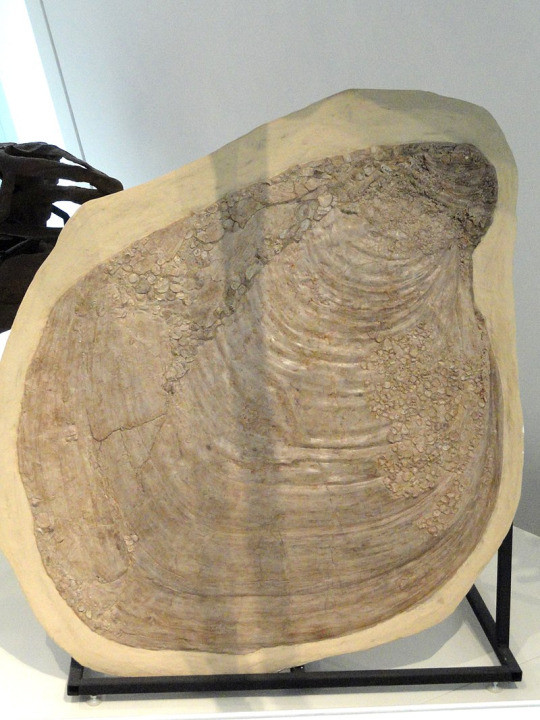
Platyceramus on the other hand is the largest bivalve ever. Typically around 3ft 3 in across, the largest one on record was over 9ft across!
Which of these shelled giants should move on the the next tier?
#paleontology#fossils#fun facts#march madness#science education#science#science side of tumblr#gastropods#bivalves
38 notes
·
View notes
Note
hi i saw a post about the fish playing with the human child and even though your addition to that post is 3 years old by now i would love to hear more about ftm sheephead fish :3 (no pressure btw!)
Fish curiosity, in my inbox?? It's more likely than I think, apparently! xD
First off, there's actually multiple fish dubbed 'sheephead'! There's the sheepshead- note the extra S in there- and they look like this:
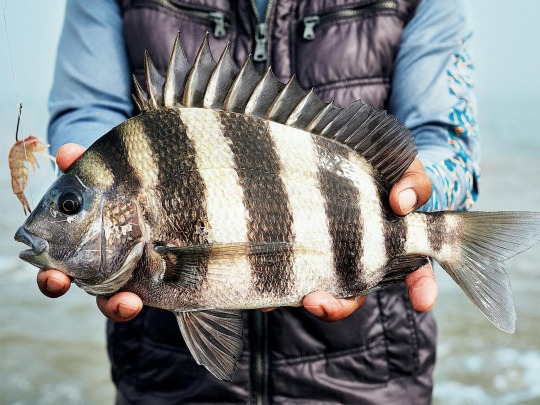
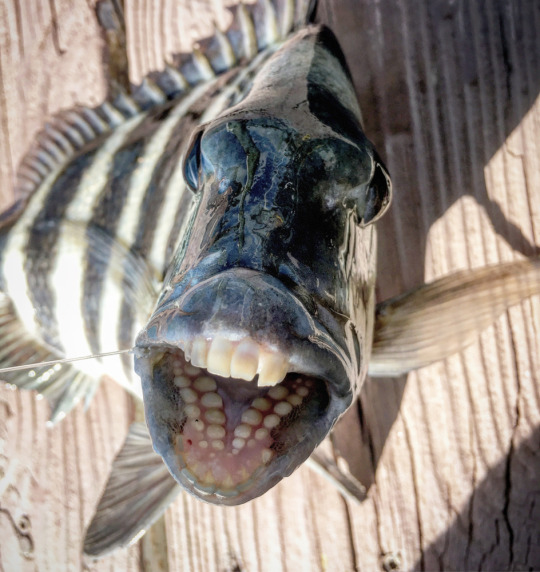
And yes those are their teeth. Horrifying tbh, but they're very good at what they do- crushing invertebrates and other shelled snacks! They're an Atlantic species that sticks to temperate and warmer waters, and they max out at about half a meter in length.
That's not the fish we're talking about today. The focus of today is the California sheephead wrasse- note the lack of a second S- also known as the 'sheephead' for short. Not confusing at all! We definitely don't bash our heads into walls over the naming conventions and lack of record-keeping of our scientist predecessors.
THIS is the sheephead wrasse, the species of the lovely and now Tumblr-famous Red! :D With a length of up to a FULL meter, they're a whole different size class of fish! They can be found along the west coast USA from the Baja Peninsula all the way up to Monterey, and dwell almost exclusively in kelp forests and nearby environments. I will use one of Red's pics as an example of female coloration-
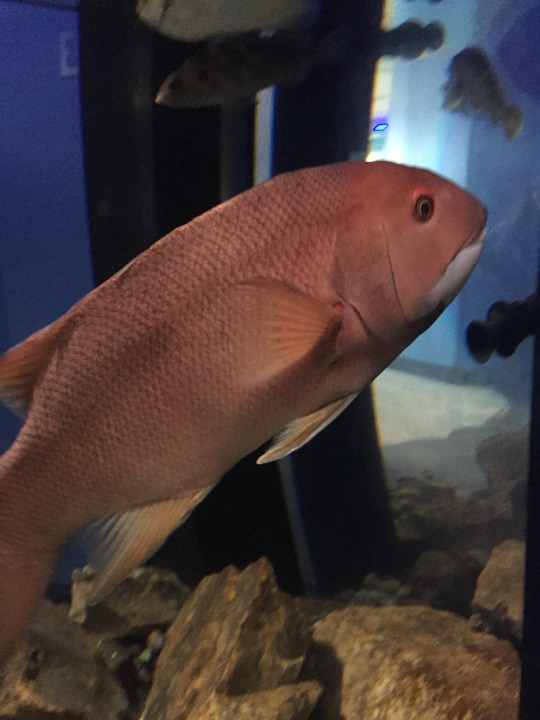
The lighting isn't great but you can see how her body is streamlined, and besides the white underside of the jaw, has a salmon-pink coloration! Females can be pink or a dull silver-beige. And much like other large marine wrasse, MALES have a drastically different appearance.
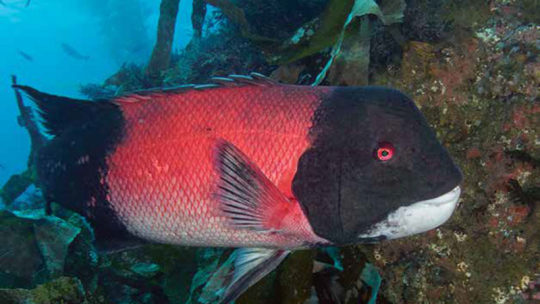

This thing is built like a damn tank!! Sheephead are a species of wrasse that shift colors to gain those striking black scales and physically bulk up when becoming males- because guess what? ALL OF THEM ARE BORN FEMALE! By default, all male California Sheephead are FTM trans :) They use that bulky head and extremely tough set of jaws to not only hunt their preferred prey- mollusks, gastropods, and bivalves, etc- but also to bash and chomp down on rival males. This one has won many battles, look at that scarred up muzzle!
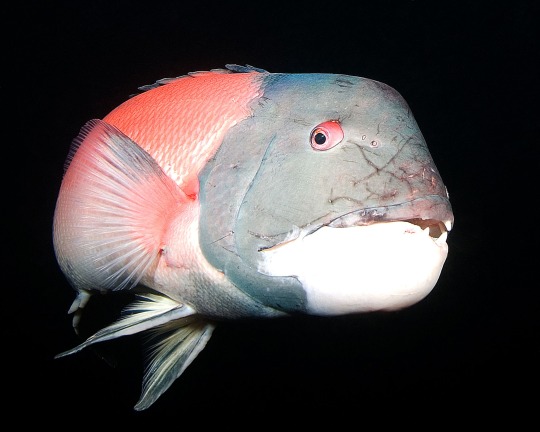
The sex change is determined by several factors, as it's not guaranteed all sheephead will eventually become males. Because sheephead school in a harem system- many females to very few males- in order to maximize pressure of stronger offspring, the biggest and healthiest sheephead male will drive out competition from the school. Naturally, a sheephead that lives longer and gains a greater size will have a much higher chance of shifting from a female to a male, if the conditions are right. Stress induced from competition can suppress the hormones that stimulate this transition in females, so they're less likely to gain size and shift from female to male if there's already strong competition taking place. However, in the event there are too few males to mate with the females, or no males present at all, the biggest female will start transitioning to fill the empty slot! It's a long process that can take as few as a couple months, or up to years, depending on resources available.
Conversely, if there are TOO MANY males, they can revert back into females! This process also takes a long time, and is a lot more rare to witness, especially because right now male California sheephead in particular are being spear-fished into becoming an Endangered species :c Sheephead adult males in good condition are considered a trophy animal in spear-fishing and similar marine trophy hunting off the West coast, and because males in particular are being targeted, the gene pool is being reduced when it wrecks the harem structure of schools.
As a fun fact- they're also an incredibly smart fish, and can form relationships with humans, as demonstrated with me and sweetiepie Red cx There's many documented cases of large marine wrasses forming long-term friendships with divers! Here's a humphead wrasse that made friends with a diver she learned would crack snails open for her with a hammer:
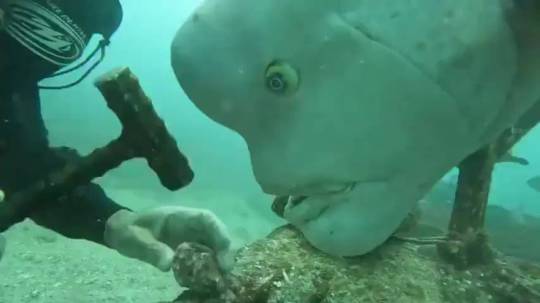
I don't work at the facility with Red anymore, but I currently work with two unnamed adult male sheephead, and once again they both like me and seem to despise all my coworkers, even if I never had the opportunity to train them like I did with little Red xD They pick favorites I guess? Now if only I could make friends with the garibaldi...
578 notes
·
View notes
Text
Did you Know
Mammal bias isn't the only one when it comes to researching nature and deep time?
There are more!
There is also time bias! As I have discussed with @quark-nova, Essentially, because the more recent something is the easier it is to learn about - more remains of things, more details from the rocks, etc. - we also have ridiculous amounts of bias towards more recent times. This is clearest when it comes to the traditional geologic time scale - the further back you go, the longer time periods are, and nothing is divided particularly evenly. I would even say the "anthropocene" is the biggest offender in this - if we zoomed out from today to a hundred million years ago, all of the extinctions and chaos of the past 2.5 million years would get lumped together into one big mass extinction, not separated out into nitty gritty and frankly narcissistic time slices.
Then there is geographical bias! You'd think people studying the whole biosphere wouldn't have this, but we do! Thanks to *colonialism!* The geologies of North America and Europe are significantly better studied than the rest of the world, which is fighting hard to catch up. This even extends to our knowledge of modern life, with many new species still being discovered in "the global south" (I personally prefer the term Gondwana, but what can you do). And we have no one to blame for that but ourselves.
And another one is land bias! Because we are land organisms, we tend to think about land ecosystems more than oceanic ones - in fact, the ocean only really gets enough time on it in the early stages of life, everything before the Silurian, because there isn't a land ecosystem to focus on more! But the oceans are just as influential in our past - honestly, moreso - than land ecosystems, even today - think about how much El Niño affects us all! But how many people know about the end cretaceous extinction, and not the mesozoic marine revolution? How many people know that reefs at the end Cretaceous were just, made by bivalves for some reason? The list goes on.
Then there's the one most people know about already - megafaunal and charismatic bias! This often goes hand in hand with mammal bias, but essentially, because we ourselves are megafauna - I know we specifically define megafauna to exclude humans, but how the hell is that logical - we operate on a big scale, at any rate - we tend to favor megafauna in our knowledge of the past and our understanding of life. And, if its not megafauna, it at least has to be charismatic - cute, extra weird maybe, or familiar. This affects modern research so much, especially conservation and research funding - not just paleo, but also neontological work. Charismatic Megafauna get everything, and everyone else gets scraps.
This is just the tip of the iceberg! All scientists bring in bias - that's why we need as many scientists as possible, so we have as many perspectives as possible to come up with the most parsimonious and universal view of nature - but some biases are fairly universal for humans and need to be murdered in our heads by all of us. Why did Wingspan and Holotype both start with North America when the best birds are in South America and the best fossil dinosaurs are in Asia? The list is infinite.
The biases we have because of the way history has played out, the way preservation works, and because of what kind of organisms we are as humans, are ones we all have to work to disassemble and deconstruct in our brains. The more we do so, the more we can look at the big picture, understand our entire biosphere, and work together to protect it.
Plus, imagine how much cool stuff we'll learn about when we finally take the time to do so.
We have nothing to lose but our chains.
306 notes
·
View notes
Text
S-2 The Dormitory of Death

Our first Deduction College character is not a pretty one, the elephant-eared dugong called Chancellor Oak. This lazy bastard is dumber than any of the students, and was only hired because he agreed to work for minimum wage. He's always sweating heavily and covered in grease. One of my worst designs yet.
DON'T READ THE EPISODES WITHOUT READING THE BOOKS!!
Logico receives the biggest dorm available, due to being the school’s nepo-baby. The other students are pissed! But not Logico. He doesn’t care about the other students. This is his story!
He does a delightful twirl into the giant bed, smushing into the silk sheets. He is ready to snuggle to success. The only thing wrong with this perfect room is a weird smell, and definitely not a good one. And then he sees where it’s coming from - a human corpse! He screams and falls out of bed.
LOGICO: Would it KILL them to CLEAN before I got here??
Even though he is a bit of a spoiled brat, no one would enjoy finding a dead body in their dorm room. He’s about to rush to complain, but then realizes it will be more important - and he may receive extra credit! - if he solves the murder himself.
He meets again with the not-so-pleasant Chancellor Oak and requests to see who was bidding on the best room before he was given it by his mother out of favoritism. The first suspect is a clam boy, fraught with emo hair. This Abalone character hasn’t spoken to a single person since he arrived.
LOGICO: Well! Where were YOU before I found a BODY in my room?
Abalone squeaks and hides himself in his hoodie.
LOGICO: Not going to talk, eh? I’ll have to FORCE the answers out of you!
Aba gasps, and lifts his hands out of his pockets to reveal boxing gloves. Chessboxing gloves!
Now a modern Logico could fight off this bivalve with ease, but this was quite some time ago, and he hadn’t learned the ways. So little Logico is punched to the ground, and the potential perpetrator tears off.
Another unlikely candidate for the room is nerdy galactic weasel Night.
LOGICO: How did you break your glasses, exactly? NIGHT: I tripped. LOGICO: Lies!
But after interrogating the mathematical whiz, he unfortunately can’t dig up any evidence.
Logico bangs his head against the wall trying to get information to come out, when he notices a note in his backpack. It’s certainly not one he made himself.
“You have a lot of potential, Logico. Have you checked the most obvious suspect?”
It’s not signed. Why would it be?
The most obvious suspect in this case would be the richest person here - Violet. A snotty moth who thinks she’s a literal princess! He glares at her from across the room, the screen width changing to feel more theatrical. Violet gasps and takes flight. Logico will not let her get away! But he’s a tad vertically challenged, and he doesn’t want to throw something and murder her. So he just jumps up and tugs on her dress. She screams, and is now carrying him across the hall! Logico intentionally slams himself against a wall. It hurts like hell, but it brings her down!
VIOLET: It’s not FAIRRRR!! I didn’t WANT to be caught! I just wanted to stink up your room!
The child is not expelled due to being rich, which is painful. But at least Logico got the last laugh. It’s what really matters!
The end!

Today's potatoes

The power of Goat Lord compels you!
See you next time murdlers!
8 notes
·
View notes
Text
❄Fallen Snow🩸 AU Creed!Reader Lore... :
(Warning: This is lore about Reader from the ❄Fallen Snow🩸 AU, which has abuse, neglect, physical abuse, self-harm, and lots of guilt from the platonic yans. This will mention self-harm, su*cidal thoughts, attempted su*cide, self-neglect, and Reader having a bad time of it all. Viewer discretion is advised...)
(Before Creed!Reader's "death")
• Creed!Reader used to try to hug everyone when they were younger, even when the other kids would hurt them. Be it by scratching or pinching them. Creed!Reader stopped trying the last year they were with the group
• Creed!Reader once accidentally killed a moth when they were trying to catch it. They buried it and held a small funeral for it. They were maybe 7 years old at that time
• Creed!Reader played by themself most of the time, so they grew a strong imagination. They also made up stories for themself
• Creed!Reader has a strong bite force, stronger than their pseudo "siblings" (Laura and Kyle), and have sharp claws as their nails, similar to Sabretooth
• Creed!Reader liked reading books. Especially about animals. Those were the only kinds of books that interested them
• Creed!Reader enjoyed games. They liked memory games, card games, and puzzles. They once solved a 500 piece puzzle on their own
• Creed!Reader is somehow related to Sabretooth and Wolverine. They were an experiment made by a different group, likely evil scientists and the like, and were "rescued" along along Laura and Kyle. Reader doesn't remember much about it, just that it was cold and there were bright lights everywhere. Laura and Kyle remember it a bit better than they do
• Creed!Reader has made small gifts for the others before, but most of the gifts weren't kept. The ones that were kept were cherished and kept safe after Reader's "death"
• Creed!Reader loved stickers. They also loved soft things, like blankets, stuffed animals, pillows, and certain clothes
• I imagine/headcanon that Creed!Reader is autistic to a certain degree
(After Reader's "death")
• Creed!Reader spent a few months in the wilderness, regaining strength and trying to survive. They were able to hunt a few animals, but always felt guilty doing so. They also were gored by a deer, bitten and cut by a bear, chased by wolves, and had to climb a tree to avoid a moose once
• Creed!Reader has various scars across their arms and legs, and the scars across their face from their mentor/s. Some scars faded, but Reader seems to always end up up another one
• Creed!Reader has self-harmed before. They tended to use their claws, scratching their arms, sometimes deep and gouging, sometimes light and thin. Those scars are the ones that stuck out to Sabretooth and Wolverine when they saw them again
• Creed!Reader had once gone a week or Teo without eating. It was cold and snowing, and they were in a depressed state. For that time, they mainly slept curled up in the cabin, crying and trying to sleep
• Creed!Reader had tried to take their life twice. Once by holding themself underwater until they ran out of breath, almost passing out... and once by strangling themself, tightening their claws around their throat until it bruised and they were gasping...
• Creed!Reader learned to bleach bones, and has made jewelry out of smaller ones. They wear some of what they've made, selling the rest
• Creed!Reader sometimes eats the prey they catch, but sell the pelts of the mammals they catch. If they catch fish, they'll usually sell the biggest ones, even collecting any mollusks or bivalves they find. Reader also can find good mushrooms and nuts, so when they can, they bring in the ones that are safe for consumption (they do make a good bit of money for the larger fish, rarer mushrooms, and finer animal pelts)
• Creed!Reader once took care of a litter of kittens that had been abandoned. They didn't live for more than a few days, but Reader made sure that all they knew was love and warmth while they were with them
• Creed!Reader likes fish, beef, mushrooms, and chocolate. They don't have to eat their food cooked, but sometimes they'd rather eat it that way, so they aren't reminded of the other ferals and what they had done (the adults and kids)
• Creed!Reader enjoys tea and coffee. They drink it whenever they don't want to fall asleep or want to stay awake (which is most days and nights)
• Creed!Reader has nightmares almost every time they sleep. They've tried to go days without sleep, but find it near impossible. The nightmares range from being killed by the group, dying, drowning in the river, being stuck with the group as though they never escaped, coughing up silt and blood, having animals eat them, the list goes on...
• Creed!Reader forages for already dead animals as well, taking bones from them and having a moment of silence for them. They bleach those bones a few times, in case the animal they came from died of disease or was infected with something
• Creed!Reader lives in the abandoned cabin, which is a little run-down. They fixed it a bit, covering the windows with old blankets or rugs or furs, insulated the walls with leftover pelts and blankets, and stocked up with items like soup, crackers, broth and broth cubes, and potatoes and eggs. They have a small, old, yet working stove with an oven. Reader also kept a nest of cleaner blankets and pillows and furs, that they nap in when needed. They have it set up by the old fireplace, so they can nap
(Meta Lore about Creed!Reader)
• Creed!Reader's past has borrowed some parts of my childhood. Being dragged off into a room by a teacher/mentor, being heavily teased and bullied by other kids, and having the adults of a school/facility dislike you (I was never physically assaulted by the teacher, but I was teased for almost all of elementary school, and most of the teachers did not like me)
• Creed!Reader accidentally killing a moth is based on the time I accidentally killed a butterfly. They held a funeral for it and said a eulogy the same way I did
• Creed!Reader and the ❄Fallen Snow🩸 AU only took a week to build up, and after a week, was when I made the first post, because i finally figured out how I wanted their story to start and the tone I wanted for the AU
• The songs I think sum up ❄Fallen Snow🩸 AU is are Daylight by David Kushner, Run Boy Run by Woodkid, Miss You by NickelBack, Runaway by Aurora, Dynasty by Miia, Sweater Weather by The Neigborhood, Bird Song by Florence + The Machine, Dear Fellow Traveller by Sea Wolf, Somewhere Only We Know by Keane, Arcade by Duncan Laurence...
(Do NOT harm yourself! If you are having self-harm thoughts or su*cidal thoughts, PLEASE go to a doctor, or other medical professional who knows how to help you with it!!! Do not eat random plants or fungi you find in the woods, as they can be poisonous or covered in a bad substance. And do not read this AU any further if it upsets you! If you like it and it does not upset you, enjoy it! Just remember your limits and triggers, okay?)
#honeycomb thoughts#platonic yandere marvel#yandere platonic marvel#platonic yandere xmen#yandere x-men#platonic yandere#platonic yandere x reader#platonic yandere marvel x reader#platonic yandere xmen evolution#platonic yandere xmen evolution au#❄fallen snow🩸 au#creed!reader
54 notes
·
View notes
Note
I understand you got an awful lotta users coming to your asks, so I don’t mind if I’m a little late on the knocking, but trick-or-treat from a wels catfish lover
You know what, my lovely friend? I'll give you something even better. How about a DAILY FISH FACT? All about the wels catfish, for you! >:DD
Daily fish fact #617
Wels catfish!

This large nocturnal fish has a varied diet, as adults can eat fish, worms, bivalves, crustaceans, leeches, amphibians and even birds, snakes or small mammals! It is one of the biggest freshwater fish and they grow quite fast indeed, typically growing at a rate of one kilogram (2 lbs) a year (in the UK), but they are able to grow even faster, even 4.5 kg (10 lbs) a year!
126 notes
·
View notes
Text
Shell

we sell seashells by the seashore this sunny Sunday, folks. seashells come in many beautiful and varied designs, such as the infamously iridescent abalone, the starlike long spined limpet, and this rose nautilus shell that almost looks too good to be real



this is the largest snail shell in the world, belonging to the Syrinx Auranus or False Trumpet snail. These behemoths can weigh up to 40 lbs.!

of course the biggest, as we all know, are giant clams, weighing in at a whopping 440!
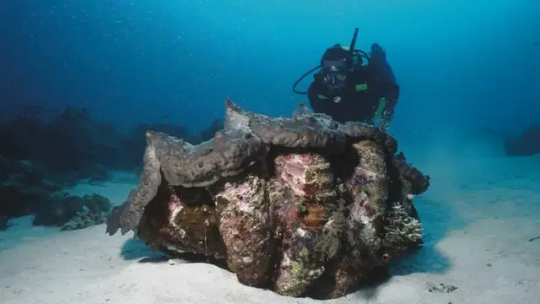
I also can't not mention the ingenious design of the violet sea snail (Janthina Janthina) which uses clear chitin air bubbles in its shell to float about harmlessly on the water's surface.
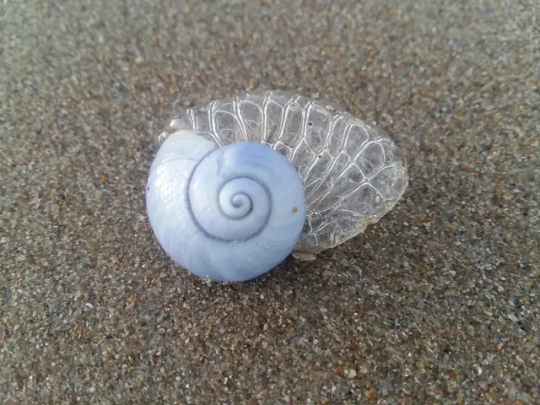
in terms of uses nowadays, you'll mostly find shells in jewelry or kitschy decorations


as well as the rare and expensive modern use of handmade mother of pearl inlay

but, as with all the previous materials, shells have their historic uses as well, for things like early axes, shovels, scrapers, fishhooks, and even oil lamps. And of course, the shell trumpet.

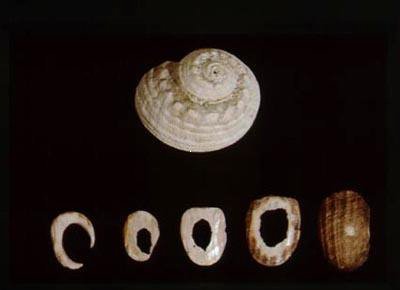


I bet you can't guess what the windowpane oyster was historically used for

shells have been used for buttons for many years too! works like a charm!
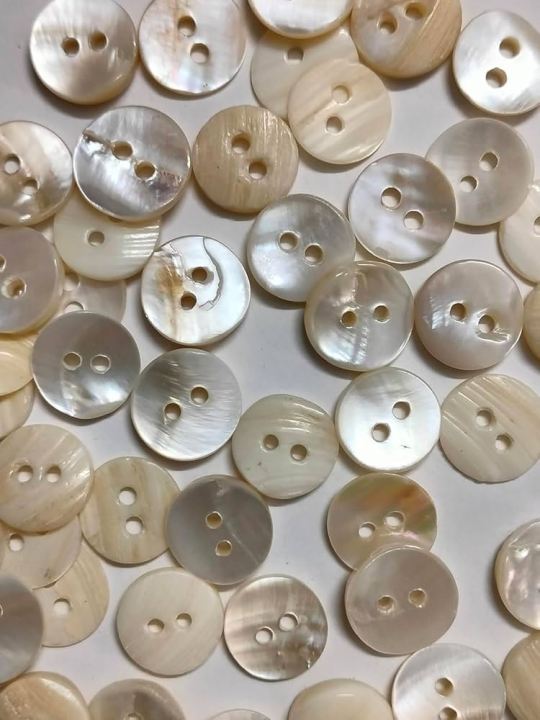
of course there are the luxury nonsensities, as there always are. Like this nautilus cup from 1600s Netherlands

shells were even used as currency themselves at one point, like the quahog clamshell wampum of the Iroquois, or cowrie shells traded all over Africa and Asia


of course, it's not just seashells that were used. We know how much of an impact the popularity of real turtleshell goods had on wild populations. With our new 30th century tools though, such cruelties are a thing of the distant past, being able to recreate authentic hawksbill shell down to the molecular level! Don't you just love modern technology?

Oh, here's another thing shells are good for! the calcium carbonate in them can be burned and crushed down to make a kind of quicklime for concrete. Maybe you'll see the return of that later for our cement showcasing, eh?

lastly, I feel it necessary to mention at least one tale of caution in working with shells. Gillian Genser made this beautiful sculpture of Adam, the first man, from blue mussel shells. Unfortunately, unbeknownst to her at the time, the filter-feeding of bivalves like the mussels she worked with cause an accumulation of heavy metals in the shells, the fine dust of which was inhaled by her over time and led to lifelong disability from poisoning. We love to say that artists suffer for their work, but in this case that's a suffering I'd rather you avoid if you know you should!

well that's all for now! I'll shelve the shells for another day, and see you tomorrow!
#uncrafting's items#multiple items#organic#terra certified#shells#tools#decorations#lighting#house stuff#art supplies
3 notes
·
View notes
Text
Hartlepool, Feb 25
I spent the weekend in Hartlepool recently, with the express purpose of the trip being to spend time at the beach. Husband and dog in tow, we boarded a train from Sheffield, then another two trains to York and Hartlepool. On the way, I wondered about what I’d find.
Hartlepool is on the north east coast of England, a little ways south of Newcastle. The east coast doesn’t have the same sort of variety of sea creatures as the west and south coasts, but that’s not to say the east coast is boring by any means. It’s where I grew up, where I’ve spent the majority of my time beach combing, and where my love of the sea and its creatures started. The entire British coastline teems with life, which makes every bit of it special. I’d never been to Hartlepool before either, so I was excited. My guess was that it would be a sand or shingle beach, like much of the rest of the east coast.
Off the train, a quick lunch and then on to confirm my suspicions. We were staying close to the marina, but there was access to a proper beach not too far away. Down a set of concrete steps, the bottom few of which would clearly be submerged at high tide, to the sea.
Amongst the rocks piled up as sea defences, were absolute masses of black seaweed, thousands of barnacles and some of the biggest limpets I’ve ever seen.

The image above perhaps doesn’t do it justice. Some of the limpets were almost the size of my palm, able to stay secluded and safe enough, nestled in the rocks to avoid becoming food for any of the local seabirds or other creatures that might enjoy them.
Many of the rocks also were home to a number of mussel type bivalves, clustered together in bustling communities. Like the limpets, sheltered from the birds and other predators by the rocks and the tide.

Once I’d managed to tear myself away from the rocks and pools surrounding them, (and believe me, that was a challenge!) I turned my eyes to the water itself and the rest of the beach. The tide was all the way out, and just starting to come back in. My dog was contenting herself by paddling in the surf, tail wagging as she jumped among the rising waves.
Normally when I go to a beach, there’s one creature in particular that sticks out to me, and ends up defining the visit. This changes depending on the beach itself, the time of year, and what I’m lucky enough to see. Sometimes it’s something that feels rare and special, other times it’s just about sheer volume. This time, it was the latter. There were so many of these little shells scattered in the sand.

They varied a fair bit in colour. I found the yellow ones (pictured) particularly interesting, but many were lighter, with cream coloured bands. Some of the yellow ones had greenish tinges to them, although my camera didn’t pick that up especially well. Lots of them looked like this, the shells still attached but fanned out like a butterfly’s wings. Others had come apart, single colourful shells sticking out of the sand.

Despite their differences, all of them had the coloured bands like tree rings, all of them had this lovely wing-like shape, and subtle vertical stripes crossing their ‘rings’. Most also had a purple or blue ish interior. I didn’t take my coastal wildlife spotting guide away with me, mostly because we were doing a lot of walking and I didn’t want to carry it around, but I had a look for these creatures when I got home. Both my guide, and a quick reverse image search, seem to suggest that they are Banded Wedge Shells, or Donax vittatus. Apparently, they are most common on the south and north west coasts, but widespread across the UK.
I also found some of the usual suspects, mussel shells, common cockles and razor clams. I was surprised by the seeming lack of whelk and oyster shells. At this point, I hadn’t seen any evidence of crabs or anemones either which was also surprising given the amount of rocky nooks that seemed ideal for them. Because this was quite a flat beach though, the tide was rising quickly, and both my husband and dog were starting to get cold and frustrated with my lack of pace, so we moved on.
… to another beach! Hartlepool has a headland, meaning save for a few private industrial areas, you can more or less walk around the entire peninsula on the coast. We moved a bit further away from the marina, and onto headland north beach. Despite only being a 40 minute walk away, it had a very different feel from the first beach we visited. Not much in the way of high sea walls and man made rocks as sea defence. No thick layer of coal dust or charcoal settling on the sands. Not surprisingly then, we found different creatures!
I found evidence of crabs, but unfortunately no live ones. The tide was still rising, and as it did we could see lots of little bubbles in the surf, rising from tiny holes in the sand where no doubt crabs, clams or worms lie buried beneath our feet. I had to discourage my dog from digging into the sand so as not to disturb or harm them. I don’t think she is fast enough to catch them, but you never really know.

The coastline is more exposed here, and so there was much chunkier debris on the strandline as well. Some very smooth and interesting looking pieces of driftwood, as well as knotted rope and as much as it pains me to say it, a lot of plastic. But here there was also evidence of some interesting creatures as well. A very large star fish arm, empty crab shells and some decently sized sea snail shells. There were some rock pools here too, so I spent some time fruitlessly looking for crabs and anemones.

We weren’t able to stay on this beach as long as I would have liked. The day was waning, the tide was coming in and all three of us needed some food and a little rest. We did take a slight detour through the Heugh Battery museum, which is well worth the visit for any historian.
The following morning, we were back on the beach. Well, we were also on the beach at night, but I have no decent photos of that for obvious reasons. The tide was outgoing, and due to start rising again in a couple of hours. Again, we started with the sea defence rocks and surrounding pools. At last, I found my anemone!

A solitary and lonely jewel in the rock. I would have loved to see them at high tide, but alas, where I was standing to take the photo would be submerged by that point. I still kept a close eye on the rocks, encouraged by having seen this one, but found no others. Maybe there were lots behind rocks that I just couldn’t see!
The sea wasn’t done surprising me though. As the tide was low, lots of pools were exposed, and full of interesting creatures, even if I couldn’t see all of them. One thing that did surprise me though, was this little sea snail. Live, perched on some rock, nestled in a pool close to a jetty.

As you can see, this little guy also had passengers! You can just about see one of them fanning out to feed. I couldn’t quite work out what type of barnacles these were, and there were too many of them on the snail shell itself for me to feel confident in ident the type of sea snail. My guess is they are a common whelk though. I hope whatever was on that rock was tasty for them. In a nearby pool, there was evidence of similar creatures having attracted the attention of the seabirds. I like to think this one managed to stay safe and returned to the sea when the tide turned again.
Because my dog is a Labrador though, she is a water baby and was pining for a dip in the sea. We moved away from the pools and close to the surf so she could have a play in the water. Of course, I kept my eyes peeled for any other treasures on the shoreline. Like the previous day, there were a large number of Banded Wedge shells, mussels, razor clams and cockles. There were also a fair amount of sea bricks and other pebbles that are more common on the industrial shores of the UK. I even found some sea glass. But I think even more interesting than the sea glass, was this small shell my husband found.

Now, I was unable to find this one in my book. However, a reverse image search seemed to suggest that this is a striped Venus clam. Supposedly found on all British coasts but no records of any sightings on the south east coast. I don’t remember seeing anything like this, at least not recently. Having said that, the south and south east is where I’ve spent a good chunk of my time by the sea. What a lovely find, to round off an absolutely wonderful trip. After returning this shell to the sea, it was time to head back to the train station.
It might seem odd to some people that you can visit a town without really visiting it. If someone said to me, “What is Hartlepool like?” I don’t think I’d be able to give them an answer beyond the fact that it’s got some lovely beaches and lots of wildlife to see. But, such is the life of a Strandliner.
#sea critters#beach#beachcombing#ocean life#ocean creatures#british wildlife#British coast#coastal#hartlepool#rockpool#sea creatures#rock pools#seaweed#sea shells#sea snail
2 notes
·
View notes
Text
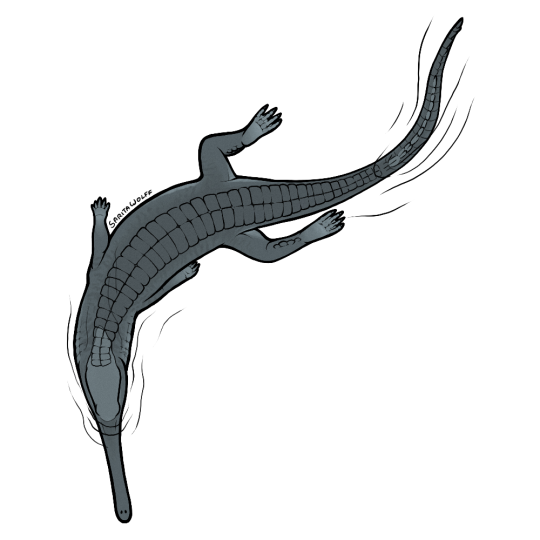
#Archovember Day 11 - Macrospondylus bollensis
The Thalattosuchians were a clade of marine pseudosuchians commonly called “marine crocodiles” or “sea crocodiles”. They were seperated into two groups, the Teleosauroids and the Metriorhynchoids. The metriorhynchoids seemed to be adapted for spending all their time in the water: they had smooth, scale-less skin, tail flukes, and even flippers. Meanwhile, teleosauroids held onto their crocodyliform nature, retaining their osteoderms and probably heading onto land when needed. They inhabited a wide range of habitats: from semi-marine coasts and estuaries, to open-ocean, to freshwater. The Early Jurassic Macrospondylus bollensis was one of these teleosauroids.
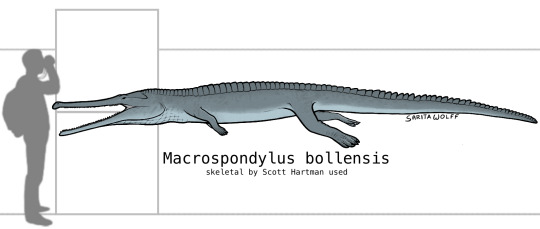
Macrospondylus bollensis, long known as “Steneosaurus bollensis” (Steneosaurus being a wastebasket taxon for thalattosuchians) finally had its genus revived in 2020. At 5.5 m (18 ft), it was the largest known Early Jurassic crocodylomorph. Like many other teleosauroids, it had a long, tapering snout, similar to its modern equivalents the gavialids. This snout would have allowed it to quickly maneuver through the water with little resistance, snapping up fish. Oddly enough, like Megalosaurus, Macrospondylus is also represented in the Crystal Palace gardens (though they are simply labeled as Teleosaurus). Modeled after gharials and based on much better preserved fossils than Megalosaurus, the teleosaur statues actually hold up pretty well, other than using a more crocodilian scute pattern.
Macrospondylus bollensis fossils have been found in Germany, the UK, and Luxembourg. It lived in the newly forming Tethys Sea, which was warm and shallow at the time, dotted with small tropical islands where Macrospondylus would have likely emerged to bask in the sun. This area is known for its fossilized crinoids, cephalopods, bivalves, crustaceans, ichthyosaurs, sharks, bony fish, and more, often exquisitely preserved “frozen in time” due to sudden events and nigh perfect fossilization factors. There was an abundance of fish here for Macrospondylus to feast upon, including chimaeras like Acanthorhina, the armoured Dapedium, the long-bodied Euthynotus, pups of the shark-like Hybodus, the herring-like Leptolepis, and many more. It would have lived alongside a variety of icthyosaurs, small plesiosaurs, other teleosauroids such as Mystriosaurus, Pelagosaurus, and Platysuchus, pterosaurs such as Campylognathoides and Dorygnathus, and come across sauropods such as Ohmdenosaurus wandering the shorelines. But Macrospondylus was not the biggest “fish” in the sea, and if it ventured into the open ocean it could have come across the 8–10 metre (26–33 ft) long icthyosaur Temnodontosaurus, the apex predator of the Early Jurassic Tethys Sea (which is also on display at the Crystal Palace!)
#my art#SaritaDrawsPalaeo#Macrospondylus#Macrospondylus bollensis#Teleosauroid#Teleosaur#Thalattosuchians#Crocodyliforms#pseudosuchians#archosaurs#archosauromorphs#reptiles#Archovember#Archovember2023
10 notes
·
View notes
Note
for the oc ask game could u do 15, 16, 28 for tris,, and 9, 30, 32 for vin? :]c
heehee hoohoo let's goooo
Trissy:
15. how big or small is their family? who did they live with growing up? do they live with anyone now?
tristan has three siblings- an older sister, a younger sister, and a younger brother, along with his mother and father, all of whom he lived with growing up. he's a real momma's boy, and has issues with his father, who's an short-tempered alcoholic. he also has an undeveloped but present extended family, given he's Irish and from the midwest. who he lives with now depends greatly on AU, obviously in fo4 his family hasn't survived, but in many other settings they're still around.
16. do they have any pets? what do they call their pets?
yes! he has a pet magpie named Maxene, who he rescued from a flock of synth crows and repaired her broken leg. she's trained very well, if a bit mischievous. if he ends up with a horse in any setting, her name is Laverne. both these are intentionally named after members of the Andrews Sisters, of which he's a huge fan <3
28. how do they show that they care about someone? how do they express that they don't like someone?
ohh that's a fun one :] his primary languages of affection are acts of service and affirmation. he's also not exactly brave or heroic, but if he cares enough about someone he'll push himself to extreme lengths in their defense, more so than he'd ever do for his own well-being or safety. he also does lots of mundane tasks as signs of care, trying to anticipate needs and do little favors, expecting nothing in return.
if he doesn't like you, well, that's a lot more obvious. while he's typically very polite, he has both a vicious passive-aggressive streak and a potentially very petty temper. it's the irish/short-person rage. he's been known to spiral (thanks to the ocd) over irrational dislikes of people, although usually his venom is reserved for people who visibly deserve it. for such a well-spoken man he sure cusses up a storm
Vin:
9: favorite food? least favorite? are they a picky eater? do they have any dietary restrictions?
vin loooooves seafood and anything fried, lots of southern comfort foods. he also really loves strawberries. despite the autism, he's surprisingly tolerant of weird foods, and will eat just about anything once if dared to. he's a man who will eat bell peppers like they're apples.
the only thing he CAN'T eat is bivalve shellfish, particularly oysters. this doesn't stop him from trying, because even though they make him feel real sick, he's convinced that toughing it out is part of the experience of eating them, and everyone else is handling it just fine.
....the man is allergic to them. idiot.
30. do they smell like anything notable?
Faintly of cigarettes, and old spice or something pine-scented :]
32. do they have any habits that aren't particularly self-destructive, just maybe odd?
well he's got a bit of the tism, so "odd" applies to a lot of his habits lmao. his biggest one is definitely his habit of playing with knives, not necessarily with the intent of hurting anything other than a tabletop, but just for fun. he'll throw em, spin em, challenge people to five finger filet, and carve stuff with em. let him have his stim behavior!!
4 notes
·
View notes
Text
Life in the Ordovician
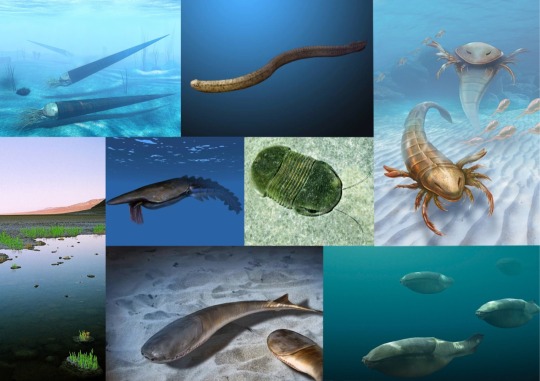
(top left: Endoceras; top middle: Promissum; top right: Pentecopterus; middle left: Aegirocassis; middle right: Bumastus; bottom left: first land plants; bottom middle: Sacabambaspis; bottom right: Arandaspis)
Art by:
Bumastus - Obsidian Soul
Promissum, Aegirocassis, Sacabambaspis - Nobu Tamura
Endoceras - AStepIntoOblivion
Pentecopterus - Patrick J. Lynch
Arandaspis - Christian Darkin
First land plants - Tahoenathan
After the Cambrian Explosion we reach the “Great Ordovician Biodiversification Event“ or GOBE (which, admittedly, sounds a lot less catchy than Cambrian Explosion).
The Ordovician starts directly after the Cambrian about 485 million years ago. Life really started to diversify during this period and came up with a lot of new and more modern forms (as far as you can call something that‘s 485 million years old “modern“). Groups like gastropods (slugs and snails), bivalves (shelled marine invertebrate) and brachiopods (shelled molluscs like clams, oysters, etc.) started to gain prominence. It really is a shame that, as a vertebrate myself, I am biased to things that also have bones and therefore won‘t talk a lot about those critters (maybe at some point i have to dig deeper into them). I can however tell you that those groups became very important to marine ecosystems and that the brachiopods especially are characteristic for the “paleozoic fauna“ in contrast to the “cambrian fauna“. Also, the fact that paleontologist distinguish between those two should give you a hint as to how impactful the GOBE really was.
Trilobites like Bumastus, which first originated in the Cambrian, were doing very well and diversified further. Most of them were bottom dwelling and relatively small, but the biggest ones, which lived during the late Ordovician could reach up to 70 cm. Just like the gastropods, bivalves and brachiopods, they were mayor players of their time, and just like them, they get concerningly little attention in relation to how big of a group they were and how important they were to our Earth‘s history. Although, I suppose I am part of the problem here, because I could go into deep detail about them right now. I‘m just not going to. Maybe some day…
While the trilobites were running around on the ocean floors some of the earliest chordates slowly turned into fish. They were of course a very basic type of fish. We call this group Agnatha, which translates to “no-jaw“, because, well, they didn‘t have jaws yet (they did have teeth though). Some jawless fish are still alive today, the lampreys and hagfish. They are truely disgusting, slimy, blood-sucking, eel-like creatures. The extinct jawless fish include the conodonts like Promissum. For the longest time scientists had no idea what kind of animal conodonts were, because the only parts of them that fossilized were their cone-shaped teeth (that‘s also where they got their name). Those teeth however were found everywhere and they are very important fossils, because by looking at them geologist can determine from which geologic age a fossil site is. Relatively recently we then started to find better preserved fossils, that revealed that conodonts where also eel-shaped and had big eyes. The other type of extinct jawless fish were the Ostracoderms like Sacabambaspis or Arandaspis. They are usually better preserved because their heads were covered in boney armor which fossilizes much better than the wiggly soft bodies of the conodonts.
One of the biggest names of the Ordovician was Endoceras, a shelled cephalopod (related to squids and octopus). And by big I mean that this weird ice cream cone was more than 3 m long. Another famous group that got their start during this time are the eurypterids, the sea scorpions, like Pentecopterus. Neither were they real scorpions (they were arachnids though, so close enough), nor lived they exclusively in the sea as there were a lot of fresh water species. There are some suggestions that they might have been able to at least briefly walk on land and breath in the air. They were also some of the biggest arthropods that ever live. Pentecopterus for example was about 1.7 m long and it wasn‘t even the biggest eurypterid (we‘ll get to that one later). They weren‘t all massive, but sizes of 1 m and more were not rare and to be honest, that‘s already way to big for any bug of my liking.
While all those new linages arose they slowly outcompeted many of the Cambrian weirdos I talked about last week. Some held on longer than others though. The Radiodonts (Anomalocaris and friends) declined during the Ordovician, but it was also the time during which we see the biggest one of them: 2 m long Aegirocassis. It was a filter feeder, so basically a giant whale of its time.
As all of that was happening in the oceans, another revolution happened quietly on the shores of our early planet: We see the very first land plants. Those early plants would have been non-vascular plants (vascular tissue is basically the plant equivalent to blood vessels; and it had not developed yet). They would have looked similar to mosses.
Even though those early plants wouldn‘t have looked very exciting, they would have put a lot of work into terraforming the world. It is believed that their photosynthesis lowered carbon dioxide levels in the atmosphere and that this might have caused temperatures to drop, turning the late Ordovician into an ice age. We know for certain that this drop in CO2 levels and temperature happened. If it was actually caused by the photosynthesis is another questions, though. Another suggestion, that also makes plants the culprits, is that their roots increased the erosion of rocks and this erosion involved the reaction between the rocks and CO2 from the atmosphere. Another reason for increased erosion could have been vulcanism creating a lot more “new“ rocks to erode. An (to my ears) absolutely wild theory is that the earth actually didn‘t cool because of lower CO2, but instead got hit by a gamma-ray burst, which sounds like something out of a scifi-movie. Apparently a gamma-ray burst is an intense energy beam, that is caused by a supernova (I really know nothing about space…), and it could have stripped our planet very quickly of our ozone layer. As ozone is a greenhouse gas, just like CO2, that would have also caused a cool down.
Whatever it was, at the end of the Ordovician the earth froze over. Drastic changes in temperature usually lead to extinction and that was the case here as well. The Late Ordovician Mass Extinction killed around 85 % of marine species, which is a pretty big deal when you consider, that almost all species at the time were marine species. It is often seen as the second-worst of the mayor “big 5“ mass extinctions (we’ll get to all the other ones in the future, don‘t worry about it). But, unlike many other mass extinctions, it didn‘t have a mayor impact on the fauna and most groups of life recovered and re-diversified after the extinction. But that‘s a story for another time.
Again, all the info from wikipedia. I got some stuff about jawless fish here.
12 notes
·
View notes
Text
I really wasn't expecting this to get so many notes, thank you to everyone who cares about this issue.
A few more things to add!
the Monterey Bay Aquarium! (I don't know enough about marine topics to offer much here, sorry! but restoring eelgrass beds and bivalve communities is a big topic)
THE WILD SEED PROJECT, dear lord HOW could I forget you my beloved??? not just a nursery but an incredible resource for native landscaping in the northeast
Prairie Moon Nursery
Pinelands Direct Nursery
Ernst Conservation Seed
Landscape Interactions
Join a seed saving club, a facebook birdwatching club, a native plant society, any sort of local or university club that gets you closer to nature and around other passionate people
Possibly the biggest thing I forgot on this... GET THE WORD OUT! Educate yourself but then pass it on. Talk to your neighbors. Get out into your community and change some minds. Put signs up in your yard (you can get your yard certified and get signs through Xerces, National Wildlife Federation, and Monarch Watch, to name a few).
keep your cat indoors i s2g
SOME PRINT BOOKS! BOOKS ARE YOUR FRIEND
Bringing Nature Home by Doug Tallamy (the holy book for us conservationists; also see his other books, Nature's Best Hope, and The Nature of Oaks)
Planting Native to Attract Birds To Your Yard by Sharon Sorenson
A Northern Gardener's Guide to Native Plants and Pollinators by Lorraine Johnson and Sheila Colla
anything by BERND HEINRICH
anything by THOR HANSON
anything by HEATHER HOLM
Braiding Sweetgrass by Robin Wall Kimmerer (she teaches at my university!)
A New Garden Ethic by Benjamin Vogt
And so many more.
Planet's Fucked: What Can You Do To Help? (Long Post)
Since nobody is talking about the existential threat to the climate and the environment a second Trump term/Republican government control will cause, which to me supersedes literally every other issue, I wanted to just say my two cents, and some things you can do to help. I am a conservation biologist, whose field was hit substantially by the first Trump presidency. I study wild bees, birds, and plants.
In case anyone forgot what he did last time, he gagged scientists' ability to talk about climate change, he tried zeroing budgets for agencies like the NOAA, he attempted to gut protections in the Endangered Species Act (mainly by redefining 'take' in a way that would allow corporations to destroy habitat of imperiled species with no ramifications), he tried to do the same for the Migratory Bird Treaty Act (the law that offers official protection for native non-game birds), he sought to expand oil and coal extraction from federal protected lands, he shrunk the size of multiple national preserves, HE PULLED US OUT OF THE PARIS CLIMATE AGREEMENT, and more.
We are at a crucial tipping point in being able to slow the pace of climate change, where we decide what emissions scenario we will operate at, with existential consequences for both the environment and people. We are also in the middle of the Sixth Mass Extinction, with the rate of species extinctions far surpassing background rates due completely to human actions. What we do now will determine the fate of the environment for hundreds or thousands of years - from our ability to grow key food crops (goodbye corn belt! I hated you anyway but), to the pressure on coastal communities that will face the brunt of sea level rise and intensifying extreme weather events, to desertification, ocean acidification, wildfires, melting permafrost (yay, outbreaks of deadly frozen viruses!), and a breaking down of ecosystems and ecosystem services due to continued habitat loss and species declines, especially insect declines. The fact that the environment is clearly a low priority issue despite the very real existential threat to so many people, is beyond my ability to understand. I do partly blame the public education system for offering no mandatory environmental science curriculum or any at all in most places. What it means is that it will take the support of everyone who does care to make any amount of difference in this steeply uphill battle.
There are not enough environmental scientists to solve these issues, not if public support is not on our side and the majority of the general public is either uninformed or actively hostile towards climate science (or any conservation science).
So what can you, my fellow Americans, do to help mitigate and minimize the inevitable damage that lay ahead?
I'm not going to tell you to recycle more or take shorter showers. I'll be honest, that stuff is a drop in the bucket. What does matter on the individual level is restoring and protecting habitat, reducing threats to at-risk species, reducing pesticide use, improving agricultural practices, and pushing for policy changes. Restoring CONNECTIVITY to our landscape - corridors of contiguous habitat - will make all the difference for wildlife to be able to survive a changing climate and continued human population expansion.
**Caveat that I work in the northeast with pollinators and birds so I cannot provide specific organizations for some topics, including climate change focused NGOs. Scientists on tumblr who specialize in other fields, please add your own recommended resources. **
We need two things: FUNDING and MANPOWER.
You may surprised to find that an insane amount of conservation work is carried out by volunteers. We don't ever have the funds to pay most of the people who want to help. If you really really care, consider going into a conservation-related field as a career. It's rewarding, passionate work.
At the national level, please support:
The Nature Conservancy
Xerces Society for Invertebrate Conservation
Cornell Lab of Ornithology (including eBird)
National Audubon Society
Federal Duck Stamps (you don't need to be a hunter to buy one!)
These first four work to acquire and restore critical habitat, change environmental policy, and educate the public. There is almost certainly a Nature Conservancy-owned property within driving distance of you. Xerces plays a very large role in pollinator conservation, including sustainable agriculture, native bee monitoring programs, and the Bee City/Bee Campus USA programs. The Lab of O is one of the world's leaders in bird research and conservation. Audubon focuses on bird conservation. You can get annual memberships to these organizations and receive cool swag and/or a subscription to their publications which are well worth it. You can also volunteer your time; we need thousands of volunteers to do everything from conducting wildlife surveys, invasive species removal, providing outreach programming, managing habitat/clearing trails, planting trees, you name it. Federal Duck Stamps are the major revenue for wetland conservation; hunters need to buy them to hunt waterfowl but anyone can get them to collect!
THERE ARE DEFINITELY MORE, but these are a start.
Additionally, any federal or local organizations that seek to provide support and relief to those affected by hurricanes, sea level rise, any form of coastal climate change...
At the regional level:
These are a list of topics that affect major regions of the United States. Since I do not work in most of these areas I don't feel confident recommending specific organizations, but please seek resources relating to these as they are likely major conservation issues near you.
PRAIRIE CONSERVATION & PRAIRIE POTHOLE WETLANDS
DRYING OF THE COLORADO RIVER (good overview video linked)
PROTECTION OF ESTUARIES AND SALTMARSH, ESPECIALLY IN THE DELAWARE BAY AND LONG ISLAND (and mangroves further south, everglades etc; this includes restoring LIVING SHORELINES instead of concrete storm walls; also check out the likely-soon extinction of saltmarsh sparrows)
UNDAMMING MAJOR RIVERS (not just the Colorado; restoring salmon runs, restoring historic floodplains)
NATIVE POLLINATOR DECLINES (NOT honeybees. for fuck's sake. honeybees are non-native domesticated animals. don't you DARE get honeybee hives to 'save the bees')
WILDLIFE ALONG THE SOUTHERN BORDER (support the Mission Butterfly Center!)
INVASIVE PLANT AND ANIMAL SPECIES (this is everywhere but the specifics will differ regionally, dear lord please help Hawaii)
LOSS OF WETLANDS NATIONWIDE (some states have lost over 90% of their wetlands, I'm looking at you California, Ohio, Illinois)
INDUSTRIAL AGRICULTURE, esp in the CORN BELT and CALIFORNIA - this is an issue much bigger than each of us, but we can work incrementally to promote sustainable practices and create habitat in farmland-dominated areas. Support small, local farms, especially those that use soil regenerative practices, no-till agriculture, no pesticides/Integrated Pest Management/no neonicotinoids/at least non-persistent pesticides. We need more farmers enrolling in NRCS programs to put farmland in temporary or permanent wetland easements, or to rent the land for a 30-year solar farm cycle. We've lost over 99% of our prairies to corn and soybeans. Let's not make it 100%.
INDIGENOUS LAND-BACK EFFORTS/INDIGENOUS LAND MANAGEMENT/TEK (adding this because there have been increasing efforts not just for reparations but to also allow indigenous communities to steward and manage lands either fully independently or alongside western science, and it would have great benefits for both people and the land; I know others on here could speak much more on this. Please platform indigenous voices)
HARMFUL ALGAL BLOOMS (get your neighbors to stop dumping fertilizers on their lawn next to lakes, reduce agricultural runoff)
OCEAN PLASTIC (it's not straws, it's mostly commercial fishing line/trawling equipment and microplastics)
A lot of these are interconnected. And of course not a complete list.
At the state and local level:
You probably have the most power to make change at the local level!
Support or volunteer at your local nature centers, local/state land conservancy non-profits (find out who owns&manages the preserves you like to hike at!), state fish & game dept/non-game program, local Audubon chapters (they do a LOT). Participate in a Christmas Bird Count!
Join local garden clubs, which install and maintain town plantings - encourage them to use NATIVE plants. Join a community garden!
Get your college campus or city/town certified in the Bee Campus USA/Bee City USA programs from the Xerces Society
Check out your state's official plant nursery, forest society, natural heritage program, anything that you could become a member of, get plants from, or volunteer at.
Volunteer to be part of your town's conservation commission, which makes decisions about land management and funding
Attend classes or volunteer with your land grant university's cooperative extension (including master gardener programs)
Literally any volunteer effort aimed at improving the local environment, whether that's picking up litter, pulling invasive plants, installing a local garden, planting trees in a city park, ANYTHING. make a positive change in your own sphere. learn the local issues affecting your nearby ecosystems. I guarantee some lake or river nearby is polluted
MAKE HABITAT IN YOUR COMMUNITY. Biggest thing you can do. Use plants native to your area in your yard or garden. Ditch your lawn. Don't use pesticides (including mosquito spraying, tick spraying, Roundup, etc). Don't use fertilizers that will run off into drinking water. Leave the leaves in your yard. Get your school/college to plant native gardens. Plant native trees (most trees planted in yards are not native). Remove invasive plants in your yard.
On this last point, HERE ARE EASY ONLINE RESOURCES TO FIND NATIVE PLANTS and LEARN ABOUT NATIVE GARDENING:
Xerces Society Pollinator Conservation Resource Center
Pollinator Pathway
Audubon Native Plant Finder
Homegrown National Park (and Doug Tallamy's other books)
National Wildlife Federation Native Plant Finder (clunky but somewhat helpful)
Heather Holm (for prairie/midwest/northeast)
MonarchGard w/ Benjamin Vogt (for prairie/midwest)
Native Plant Trust (northeast & mid-atlantic)
Grow Native Massachusetts (northeast)
Habitat Gardening in Central New York (northeast)
There are many more - I'm not familiar with resources for western states. Print books are your biggest friend. Happy to provide a list of those.
Lastly, you can help scientists monitor species using citizen science. Contribute to iNaturalist, eBird, Bumblebee Watch, or any number of more geographically or taxonomically targeted programs (for instance, our state has a butterfly census carried out by citizen volunteers).
In short? Get curious, get educated, get involved. Notice your local nature, find out how it's threatened, and find out who's working to protect it that you can help with. The health of the planet, including our resilience to climate change, is determined by small local efforts to maintain and restore habitat. That is how we survive this. When government funding won't come, when we're beat back at every turn trying to get policy changed, it comes down to each individual person creating a safe refuge for nature.
Thanks for reading this far. Please feel free to add your own credible resources and organizations.
19K notes
·
View notes
Text
yellow hat Research
coral reef
For the yellow hat, I thought about using coral reefs, as the more ageing and growth of coral reefs the more homes/shelters that are created for reef life. It is estimated that by 2050 75% of coral reefs will be gone. And the more corals/clams grow the bigger they become which leads to more shelter for reef creatures which is a positive for marine life and in general.
Creatures such as sea sponges, oysters, clams, crabs, sea stars, sea urchins, and many species of fish, make coral reefs their home, I would like to centre the clip on coral reefs growing and expanding to create more homes for sea life
happy clam
As another idea, instead of going really broad, I thought about using a specific coral or creature for the black hat such as the happy clam.
They’re the biggest living members of the bivalve class, they are creatures that have 2 shells that are connected by a flexible ligament which protects the vulnerable parts of the creature. The more they grow the larger they are and the more fish and reef life can seek shelter inside the clam
The shell ridges can also provide a private, safe spot for fish egg layers or even a home for many crustations in the reef and small creatures. Reef creatures even use clam material for building their own shelter.

https://ocean-mimic.com/5-creatures-vital-to-the-survival-of-coral-reefs/
0 notes